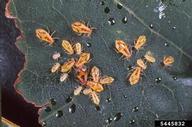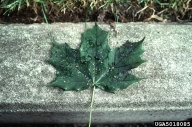Norway maple aphid
Periphyllus lyropictus (Kessler) (Hemiptera Aphidae)
Orientation to pest
Norway maple aphid, Periphyllus lyropictus (Kessler), is a European species that is invasive in the United States, where it occurs on Norway maple (Acer platanoides L.). This aphid is widespread in eastern North America, wherever Norway maple is planted. Given that Norway maple is now considered an invasive forest pest in many areas, this aphid's damage to the tree might be considered beneficial. Large populations can cause leaves to become brown or wrinkled and cause premature leaf drop. However, the primary concern is usually the large amount of honeydew it can produce, which is a nuisance to sidewalks and cars beneath the trees. Both winged and wingless forms occur and the latter form has a yellow-green body with a "lyre" shaped brownish marking on the abdomen.
Hosts commonly attacked
Its only host in North America is the imported species Norway maple (A. platanoides).
Distribution in the USA
This aphid is found widely in eastern North America, wherever Norway maple has been planted.
Images of Norway maple aphid
| Figure 1. Colony of Norway maple aphid, Periphyllus lyropictus | Figure 2. Sooty mold and cast skins of Norway maple aphid |
Important biological control agents related to this pest species
In its native range in Europe, three species of parasitoids have been recorded that are believed to be specialized on this genus of aphid: Aphidius setiger Mackauer, Trioxys falcatus Mackauer, and Praon silvestre Starý. Of these, only A. setiger is known to be present in North America.
Articles
- Starý, P. 1972. Host life-cycle and adaptation of parasites of Periphyllus aphids (Homoptera, Chaitophoridae; Hymenoptera, Aphidiidae). Acta Entomologica Bohemoslovaca 69 (2): 89-96.





